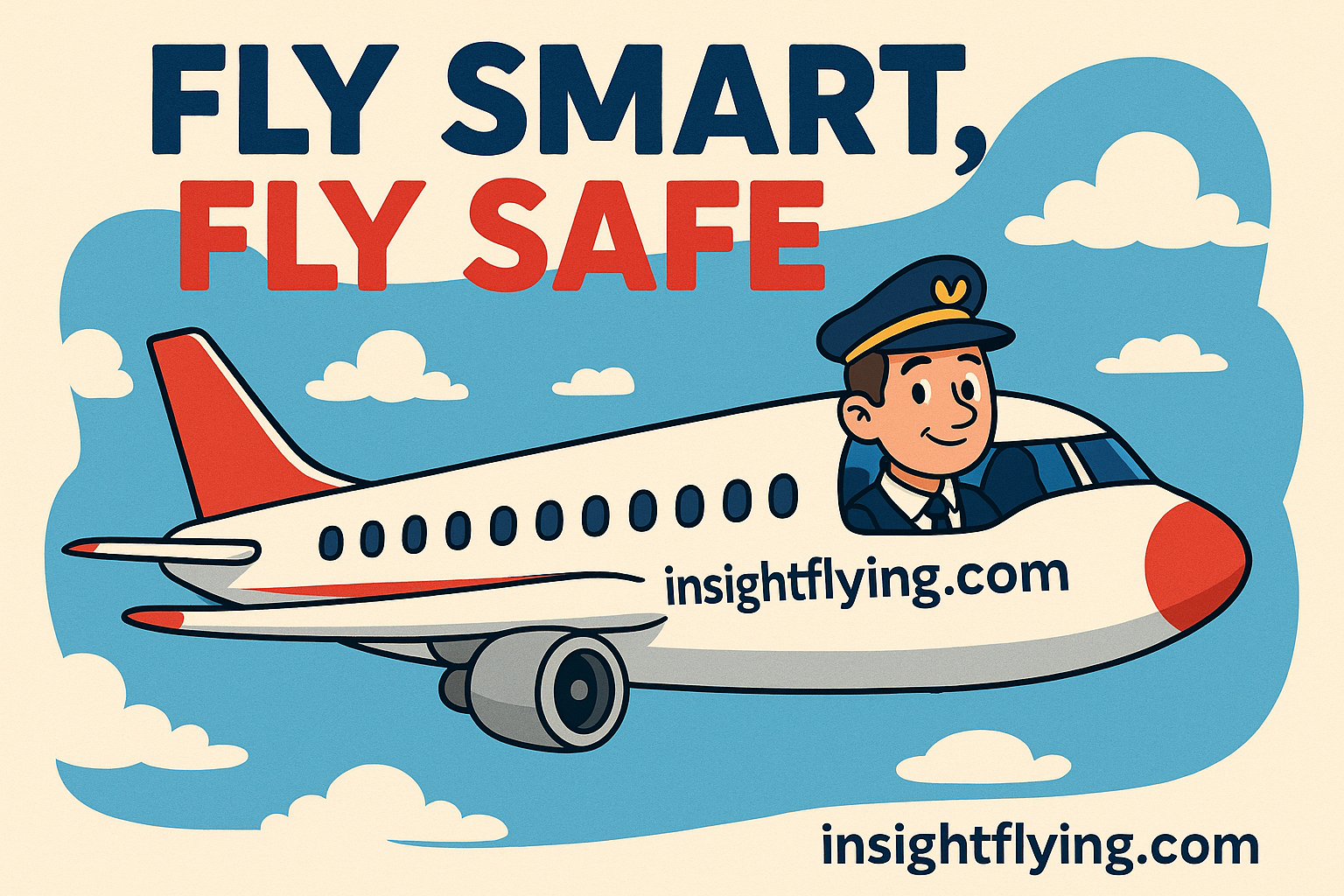เผยแพร่โดย Capt. Sopon Phikanesuan
www.insightflying.com
✈️ ขึ้นเครื่องบินอย่างมั่นใจ เริ่มจากความเข้าใจขั้นตอนเล็ก ๆ ที่สำคัญ
การเดินทางทางอากาศเป็นรูปแบบการเดินทางที่ปลอดภัยที่สุดในโลก หากผู้โดยสารและลูกเรือร่วมมือกันปฏิบัติตามมาตรการด้านความปลอดภัยอย่างถูกต้อง ทุกขั้นตอนตั้งแต่การเช็กอินจนถึงเวลานั่งประจำที่บนเครื่องบิน ล้วนออกแบบมาเพื่อให้มั่นใจว่า “ทุกคนจะถึงจุดหมายปลอดภัย”
Air travel remains the safest mode of transportation in the world, thanks to well-established safety protocols. When both passengers and crew follow procedures diligently—from check-in to boarding and seating—every step contributes to ensuring that everyone arrives safely at their destination.
1. ทำไมต้องตรวจบัตรขึ้นเครื่องหลายครั้ง?
หลังผ่านการตรวจสัมภาระและเอกสาร ผู้โดยสารจะเข้าสู่ขั้นตอนตรวจบัตรโดยสารที่ประตูทางออกขึ้นเครื่อง การตรวจนี้มีความสำคัญเพราะเที่ยวบินอาจมีการเปลี่ยนเวลา เปลี่ยนประตู หรือใช้หลุมจอดร่วมกับสายการบินอื่น การตรวจซ้ำจึงเป็นการป้องกันความผิดพลาดที่อาจทำให้ผู้โดยสารขึ้นเครื่องผิดลำ ซึ่งอาจส่งผลต่อความปลอดภัยและการดำเนินงานของเที่ยวบิน
After clearing security and baggage screening, passengers proceed to the boarding gate where their boarding passes are rechecked. This repeated verification is crucial because flight gates, schedules, and aircraft assignments often change. Multiple checks help prevent boarding errors that could compromise both safety and operational efficiency.
2. ตรวจบัตรอีกครั้งก่อนขึ้นเครื่อง – ด่านสุดท้ายของความปลอดภัย
แอร์โฮสเตสจะตรวจสอบชื่อ หมายเลขเที่ยวบิน วันที่ และที่นั่งอีกครั้งก่อนให้ผู้โดยสารขึ้นเครื่อง เพื่อยืนยันว่าเป็นผู้โดยสารที่ถูกต้องในเที่ยวบินนั้น ๆ รวมถึงตรวจดูว่าผู้โดยสารนั่งในตำแหน่งที่เหมาะสม เช่น ไม่ให้เด็ก คนชรา หญิงมีครรภ์ หรือพระภิกษุนั่งบริเวณประตูทางออกฉุกเฉิน ซึ่งต้องมีผู้ที่สามารถช่วยเหลือในกรณีฉุกเฉินได้
Flight attendants recheck passenger details—name, flight number, date, and seat—before boarding. This final verification ensures that each passenger is correctly assigned and seated appropriately. For example, passengers who are elderly, pregnant, children, or monks are not permitted in emergency exit rows, which must be occupied by able-bodied individuals capable of assisting in an evacuation.
💡 คำแนะนำจากกัปตัน:
การตรวจบัตรขึ้นเครื่องหลายครั้งไม่ได้หมายถึงความไม่ไว้วางใจ แต่เป็น “มาตรการความปลอดภัยที่ซ้อนกัน” เพื่อให้แน่ใจว่าไม่มีใครตกหล่นหรือขึ้นผิดเที่ยวบิน
3. ป้องกันเหตุผิดเที่ยวบิน – เรื่องที่เคยเกิดขึ้นจริง
แม้มีระบบคอมพิวเตอร์ควบคุม แต่การขึ้นเครื่องผิดลำยังเกิดขึ้นได้ เช่น ผู้โดยสารขึ้นรถบัสผิดคันในกรณีที่เครื่องบินจอดห่างจากอาคารผู้โดยสาร การตรวจบัตรซ้ำก่อนขึ้นเครื่องจึงเป็นขั้นตอนสุดท้ายที่ช่วยป้องกันผู้โดยสารไปผิดเที่ยวบิน ซึ่งเป็นมาตรการรักษาความปลอดภัยที่เข้มงวดทั่วโลก
Despite digital systems, boarding the wrong aircraft can still occur—especially when passengers are transported to remote stands by bus. The final boarding pass verification at the aircraft door is a critical layer of security to prevent such errors and safeguard against potential unlawful interference.
4. เบื้องหลังความพร้อมก่อนเครื่องขึ้น
เมื่อผู้โดยสารขึ้นเครื่องครบตามรายชื่อ พนักงานภาคพื้น (Ramp Master หรือ Red Cap) จะตรวจสอบสัมภาระทั้งหมดให้ตรงกับจำนวนผู้โดยสารในระบบ และคำนวณ Weight and Balance เพื่อให้กัปตันตรวจรับรองก่อนการออกเดินทาง ขั้นตอนนี้สำคัญมาก เพราะความสมดุลของน้ำหนักเครื่องบินมีผลโดยตรงต่อความปลอดภัยในการบินขึ้นและลงจอด
Once all passengers have boarded, ground operations staff (Ramp Master or Red Cap) verify that checked baggage matches the passenger manifest and calculate the aircraft’s weight and balance. The captain then reviews and signs off on these figures. Proper weight distribution directly affects takeoff performance and flight stability.
5. ทำไมต้องรีบมาที่ประตูขึ้นเครื่องก่อนเวลา
ผู้โดยสารควรมาถึงประตูขึ้นเครื่องอย่างน้อย 15 นาที ก่อนเวลาออกเดินทางจริง เพื่อหลีกเลี่ยงการล่าช้าทั้งระบบ เพราะหากเครื่องต้องรอผู้โดยสารเพียงหนึ่งคน การดีเลย์ไม่กี่นาทีอาจทำให้เที่ยวบินปลายทางช้ากว่าเดิมเป็นสิบห้านาที หรือมากกว่านั้น
Passengers should arrive at the boarding gate at least 15 minutes before departure. Even a single delayed passenger can cascade into significant delays—one minute on the ground can translate into fifteen minutes at the destination due to air traffic sequencing and taxi congestion.
🕐 คำแนะนำจากกัปตัน:
เวลาที่เห็นในบัตรโดยสารคือ “เวลาเครื่องออก” ไม่ใช่ “เวลาเริ่มขึ้นเครื่อง” การมาช้ากว่ากำหนดไม่เพียงแต่ทำให้คุณตกเครื่อง แต่ยังส่งผลต่อการหมุนเวียนเที่ยวบินของสายการบินด้วย
6. รัดเข็มขัดนิรภัยให้แน่นเสมอ
เมื่อสัญญาณรัดเข็มขัดติดสว่าง ผู้โดยสารควรกลับที่นั่งและรัดเข็มขัดทันที แม้ในขณะบินระดับ เพราะสภาพอากาศที่แปรปรวน (Turbulence) อาจเกิดขึ้นได้โดยไม่คาดคิด การนั่งอยู่กับที่และรัดเข็มขัดไว้ตลอดเวลาคือวิธีง่ายที่สุดในการป้องกันการบาดเจ็บบนเครื่องบิน
Always fasten your seatbelt when seated—even during cruise. Turbulence can occur unexpectedly, and keeping your seatbelt fastened at all times is the simplest and most effective way to prevent injuries in flight.
7. ห้ามอยู่ในห้องน้ำระหว่างเครื่องบินขึ้นหรือลง
ห้องน้ำของเครื่องบินไม่ได้ออกแบบให้ป้องกันแรงกระแทก ไม่มีเข็มขัดนิรภัย และอาจมีวัตถุแตกหักได้ หากเกิดเหตุฉุกเฉินขึ้น ผู้โดยสารที่อยู่ในห้องน้ำอาจติดอยู่ภายในและไม่สามารถอพยพได้ทันเวลา
Do not use or remain in the lavatory during takeoff or landing. Aircraft lavatories are not equipped with safety restraints and contain sharp fixtures that could cause harm during impact. In emergencies, structural deformation could trap occupants inside.
8. ฟังคำแนะนำของลูกเรือทุกครั้ง
ลูกเรือได้รับการฝึกฝนตามมาตรฐานของ ICAO Cabin Crew Safety Training เพื่อดูแลความปลอดภัยของทุกคน การปฏิบัติตามคำแนะนำ เช่น ปิดอุปกรณ์อิเล็กทรอนิกส์ ปรับพนักเก้าอี้ และพับถาดอาหาร เป็นการช่วยให้เที่ยวบินดำเนินไปอย่างปลอดภัยและรวดเร็วในกรณีที่ต้องอพยพฉุกเฉิน
Always follow crew instructions. Cabin crew are trained under ICAO standards to ensure passenger safety. Complying with instructions—such as stowing devices, upright seating, and securing tray tables—ensures that everyone can evacuate swiftly and safely if needed.
9. เคารพพื้นที่ของผู้อื่นและลูกเรือ
การเคารพกฎระเบียบและไม่ลุกเดินโดยไม่จำเป็น ไม่เพียงแต่สร้างความสะดวกให้กับผู้โดยสารคนอื่น แต่ยังช่วยให้ลูกเรือสามารถปฏิบัติงานได้เต็มประสิทธิภาพในสภาพแวดล้อมที่มีข้อจำกัดมาก
Respecting personal space and minimizing unnecessary movement help maintain a calm and efficient cabin environment. This courtesy allows crew members to perform their duties effectively in a confined and controlled space.
10. การบินปลอดภัย เริ่มจากความร่วมมือของทุกคน
ความปลอดภัยในการบินไม่ใช่หน้าที่ของกัปตันหรือลูกเรือเท่านั้น แต่เป็นความร่วมมือของทุกคนบนเครื่อง การปฏิบัติตามกฎ การมีสติ และการเคารพซึ่งกันและกันคือพื้นฐานของ “การบินอย่างมีความรับผิดชอบ” (Responsible Flying)
A safe flight depends on teamwork—between passengers, crew, and ground staff. Adherence to rules, situational awareness, and mutual respect form the foundation of responsible flying and contribute to a culture of safety that benefits everyone.
✈️ สรุป
การขึ้นเครื่องบินอย่างปลอดภัยเริ่มจากความเข้าใจในเหตุผลเบื้องหลังทุกขั้นตอน ตั้งแต่การตรวจบัตร การรัดเข็มขัด ไปจนถึงการฟังคำแนะนำของลูกเรือ หากทุกคนช่วยกันทำสิ่งเล็ก ๆ อย่างมีวินัย ก็จะช่วยให้ท้องฟ้ายังคงเป็นพื้นที่แห่งความปลอดภัยสำหรับทุกคน
Safe air travel begins with understanding the purpose behind each procedure—from boarding checks to seatbelt use. When everyone does their part with discipline and awareness, the skies remain the safest place to travel.
แหล่งอ้างอิง / References
- International Civil Aviation Organization (ICAO), Manual on Passenger Safety (Doc 10086) – https://www.icao.int
- Federal Aviation Administration (FAA), Passenger Safety Briefing Guidelines – https://www.faa.gov/passengers
- International Air Transport Association (IATA), Travel Smart: Passenger Safety Tips – https://www.iata.org
- Capt. Sopon Phikanesuan, Insight Flying – https://www.insightflying.com
